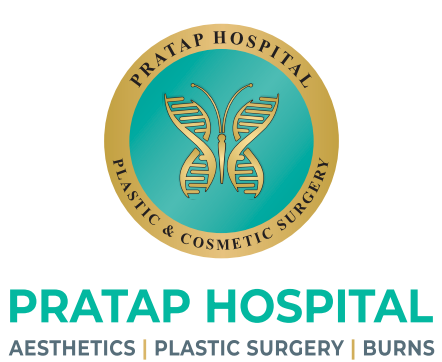
- Home
- About
- Surgical
- Non Surgical
- Burns
- Cranio-maxillofacial surgery
- Gallery
- Contact
Secondary Maxillofacial Correction — Restoring Facial Form, Function & Aesthetics After Previous Trauma or Surgery
At Pratap Hospital, Dr. Pratap Duggirala (M.S., M.Ch) offers advanced Secondary Maxillofacial Correction for patients who require improvement after earlier facial trauma treatment, congenital deformity surgery, or unsatisfactory primary outcomes.
With over 15 years of expertise in craniofacial reconstruction, orthognathic corrections, microvascular tissue transfer, and facial contouring, Dr. Pratap is trusted for delivering precise, balanced, and life-enhancing results in complex secondary cases.
Patients choose Dr. Pratap for his meticulous assessment, artistic facial understanding, and reconstructive excellence, which together restore proper facial alignment, chewing function, breathing, and aesthetic harmony.

- Why People Choose Rhinoplasty
- Why People Choose Dr. Pratap for Secondary Maxillofacial Correction
- Pre-Surgical Evaluation
- Surgical Techniques Used
- The Surgical Process
- Frequently Asked Queries
Secondary maxillofacial correction addresses deformities or functional issues that remain after:
Previous facial trauma
Primary maxillofacial surgery
Improper fracture healing
Malunited or non-united fractures
Congenital deformity correction
Jaw alignment surgeries
Facial asymmetry following edema/scarring
Bone loss or contour irregularities
Goals of the procedure include:
Restoring symmetry
Correcting jaw alignment
Improving chewing function
Enhancing facial aesthetics
Releasing scar contractures
Rebuilding defective or missing bone
Improving airway and breathing
These corrections often require precise planning and advanced surgical skill
✓ Expertise in Complex & Revision Facial Reconstruction
Extensive experience handling deformities from trauma, surgery, or congenital causes.
✓ Advanced 3D Planning & Facial Mapping
Ensures accurate alignment, symmetry, and structural restoration.
✓ Microvascular & Bone Reconstruction Specialist
Ideal for cases involving bone defects, scarring, or soft-tissue loss.
✓ Precision in Jaw Correction (Secondary Orthognathic Work)
Correcting malocclusion, bite issues, and facial disproportions.
✓ Restores Both Function & Facial Harmony
Focus on aesthetics, speech, chewing, and breathing.
✔ Clinical Examination
Facial symmetry
Bone alignment
Jaw function
Mouth opening
Soft-tissue scarring
Occlusion/bite pattern
✔ Imaging
3D CT scans
Jaw alignment analysis
Virtual surgical planning
✔ Dental & Orthodontic Evaluation
If jaw repositioning is required.
✔ Planning the Reconstruction
Includes decisions on:
Bone grafting
Osteotomies
Scar release
Soft-tissue contouring
Implants or plates
• Corrective Osteotomies
Repositioning bones of the upper jaw, lower jaw, or midface.
• Bone Grafting / Bone Substitution
Restoring bone loss from trauma or failed healing.
• Orthognathic Revision Surgery
Correcting residual malocclusion or asymmetry.
• Plate Removal & Re-fixation
Replacing old hardware with updated, anatomically precise plates.
• Contour Correction
Reshaping irregularities from fractures or previous surgery.
• Scar Release & Soft-Tissue Reconstruction
Improving facial movement, expression, and symmetry.
• Microvascular Free Flaps
For major tissue or bone loss requiring advanced reconstruction.
Step 1: Detailed 3D Planning
Simulation of bone movement and contour correction.
Step 2: Surgery Under General Anesthesia
Precise osteotomies, grafting, soft-tissue adjustments, and fixation.
Step 3: Repositioning & Stabilization
Bone structures aligned and secured for long-term stability.
Step 4: Soft-Tissue Refinement
Balancing facial contours for natural aesthetics.
Step 5: Recovery & Rehabilitation
Minimal swelling care
Bite correction guidance
Physiotherapy for jaw movement
Most improvements are visible in 2–6 weeks, with full healing over several months.
1. Why is secondary maxillofacial correction needed?
To fix deformities, functional issues, or asymmetry that remain after trauma or previous surgery.
2. Is secondary surgery more complex?
Yes, because scar tissue, old hardware, and altered anatomy require advanced expertise.
3. Will it improve appearance and function?
Absolutely — it enhances chewing, breathing, symmetry, and facial balance.
4. What imaging is required?
3D CT and virtual planning for precise correction.
5. Is recovery long?
Initial recovery is quick; full bone remodeling takes a few months.
6. Are the results permanent?
Yes — once corrected and healed, results are stable and long-lasting.
If you’re considering Secondary Maxillofacial Correction to improve facial symmetry, restore function, correct previous trauma outcomes, or refine results from earlier surgery, schedule a consultation at Pratap Hospital today.
Our team will guide you through every step — from evaluation and 3D planning to surgery, rehabilitation, and long-term follow-up — ensuring safe, precise, and life-enhancing outcomes.
📍 Pratap Hospital — Reconstructive, Aesthetic & Microsurgery Centre
Secondary Maxillofacial Correction
📞 Call / WhatsApp: +91 94929 69899
📧 Email: drpratapshospital@gmail.com

Before And After Results















